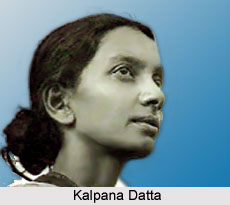 Kalpana Datta, later known as Kalpana Joshi was one of the foremost female Indian revolutionaries and an Indian freedom fighter. She was a member of the armed resistance movement, which was under the leadership of Master Da Surya Sen. Kalpana Datta was amongst the prominent members of the Indian Republican Army, which was a revolutionary group in Chittagong that included various Indian revolutionaries and Indian freedom fighters who conducted and participated in the well known Chittagong Armoury Raid Case in the year 1930. Eventually she joined the Communist Party of India. Later Kalpana Datta was married to Puran Chand Joshi, who was the General Secretary of the Communist Party of India in the year 1943.
Kalpana Datta, later known as Kalpana Joshi was one of the foremost female Indian revolutionaries and an Indian freedom fighter. She was a member of the armed resistance movement, which was under the leadership of Master Da Surya Sen. Kalpana Datta was amongst the prominent members of the Indian Republican Army, which was a revolutionary group in Chittagong that included various Indian revolutionaries and Indian freedom fighters who conducted and participated in the well known Chittagong Armoury Raid Case in the year 1930. Eventually she joined the Communist Party of India. Later Kalpana Datta was married to Puran Chand Joshi, who was the General Secretary of the Communist Party of India in the year 1943.
Early Life of Kalpana Datta
Kalpana Datta was born on 27 July 1913 at Sripur in the district of Chittagong in the Bengal Province of British India, presently at Bangladesh. She passed her matriculation examination in the year 1929 from Chittagong. Later Datta went to Calcutta (now Kolkata) and got admitted to the Bethune College for graduation in Science. She joined the Chhatri Sangha (Women Students Association).
Revolutionary Activities of Kalpana Datta
The armoury raid in Chittagong was perhaps the most surprising and valiant revolutionary endeavours in the history of the Indian freedom struggle that was devised by the youths of the region. The attack was conducted on 18th April 1930 to raid the armoury of police and auxiliary forces from the Chittagong in Bengal province during the rule of the British Empire in India. The Indian Republican Army was led by Masterda Surya Sen and other prominent members included Kalpana Dutta, Pritilata Waddedar, Anand Gupta, Jiban Ghoshal, Ananta Singh, Tarakeswar Dastidar, Harigopal Bal (Tegra), Ardhendu Dastidar, Sasanka Datta, Naresh Roy, Ambika Chakrobarty, Subodh Roy, Nirmal Sen, Lokenath Bal and Ganesh Ghosh.
Kalpana Datta became a member of the Indian Republican Army, Chittagong branch and was a part of the armed resistance group led by Surya Sen in May 1931. She was delegated with the transportation of explosives and other supplies from Calcutta. Datta also prepared gun-cotton and devised to place a dynamite fuse under the Court building and inside the prison to liberate the revolutionary leaders, who were tried in a special Tribunal. Datta, along with Pritilata Waddedar, was entrusted by Surya Sen to attack the European Club in Chittagong in September, 1931. But Datta was arrested while carrying out inspection of the area, one week before the attack. After her release on bail she went underground. On 17 February 1933, their hideout was raided by the British Indian Police and Master Da Surya Sen was arrested, but Kalpana Datta managed to escape. Later she was detained on 19 May 1933.
Trial of Kalpana Datta
The renowned Indian freedom fighter Kalpana Datta was sentenced to transportation for life in the 2nd supplementary trial of Chittagong armoury raid case. She was released in the year 1939.
Later Life of Kalpana Datta
Datta graduated from the Calcutta University in the year 1940 and eventually joined the Communist Party of India. She was married with Puran Chand Joshi in 1943 and the couple had 2 sons, namely Suraj and Chand. Chand Joshi was a well known journalist, who was employed with the Hindustan Times. Later in 1946, Kalpana contested in the elections for the Bengal Legislative Assembly as a Communist Party of India candidate from Chittagong, although she did not win. Kalpana Datta died on 8 February 1995 in Calcutta (now Kolkata).



















